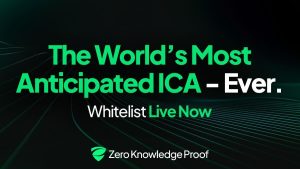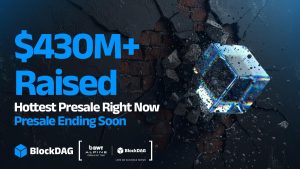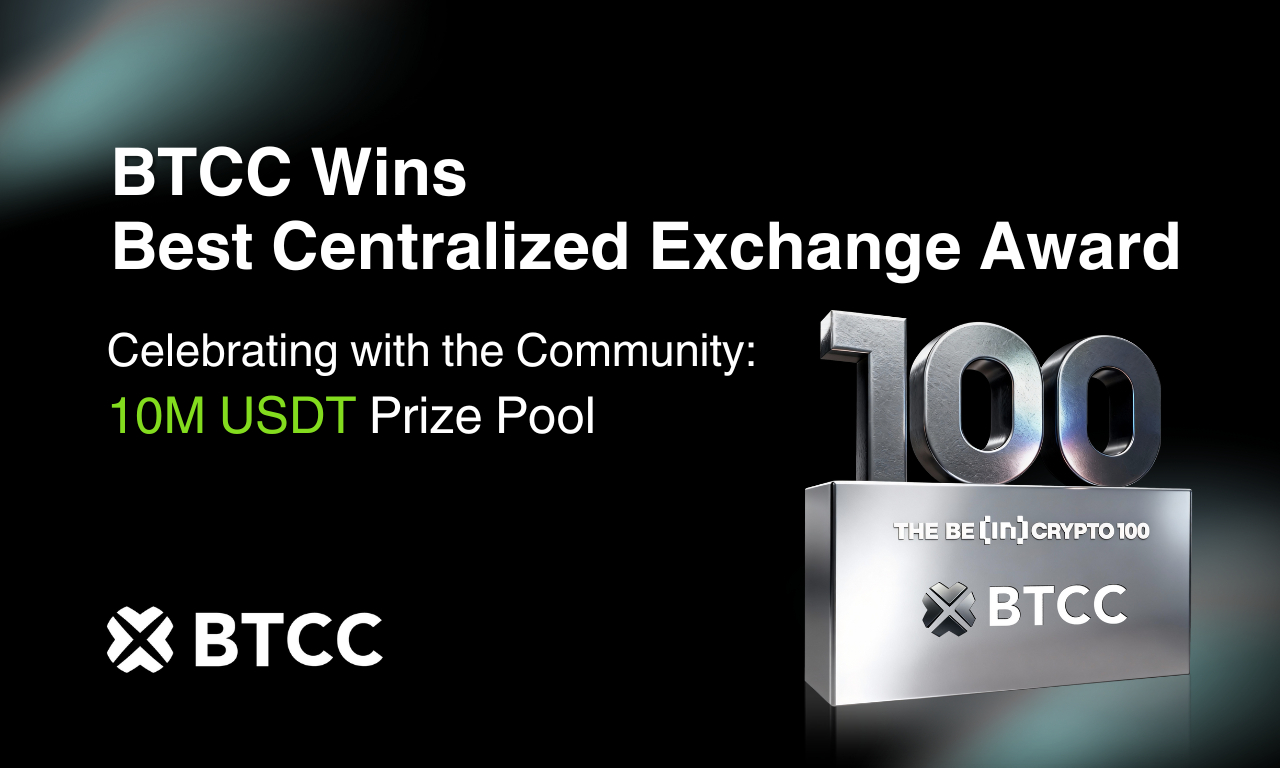
Founded by Keone Hon, James Hunsaker, and Eunice Giarta, Monad is built by a team with expertise in low-latency trading and distributed systems. The project has gained significant investment, securing $19M in a seed round led by Dragonfly Capital and $225M in a Series A round led by Paradigm.
With MonadBFT consensus, MonadDB state management, and asynchronous execution, the blockchain aims to offer faster transactions, lower fees, and an optimized developer experience while retaining full Ethereum compatibility.
Although Monad has not officially announced an airdrop, its testnet activity has drawn strong participation, with users interacting with dApps, liquidity pools, and smart contracts to maximize eligibility.
| Key Takeaways – Monad enables 10,000 TPS through parallel execution and deferred execution. – Fully EVM-compatible, allowing seamless migration of Ethereum-based applications. – Secured $244M in funding, backed by Dragonfly Capital, Paradigm, and Coinbase Ventures. |
What is Monad?
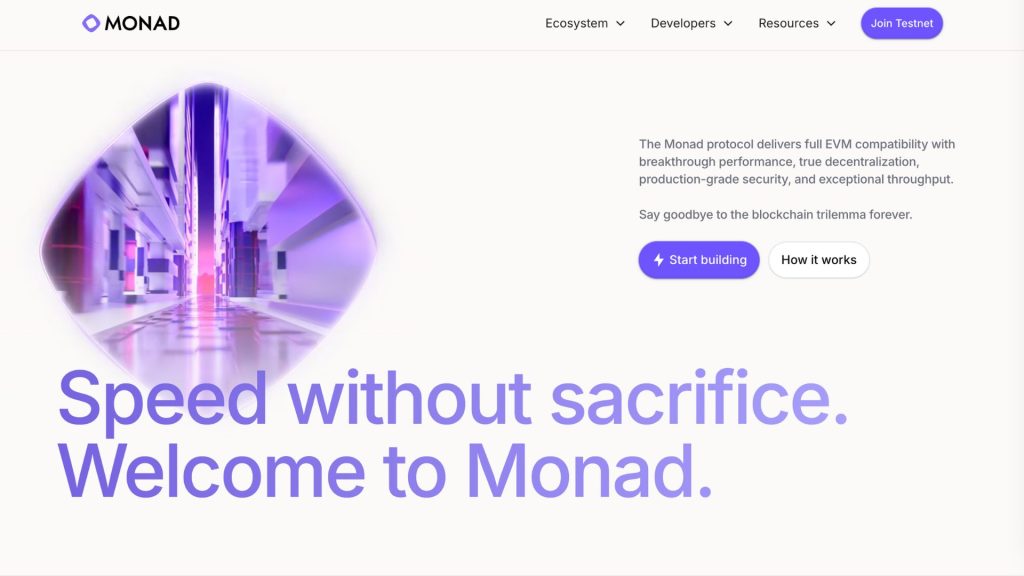
Monad is a high-performance Layer 1 blockchain designed to be fully EVM-compatible, allowing developers to port their Ethereum-based applications seamlessly. Unlike traditional blockchains that rely on sequential execution, Monad introduces parallel execution, enabling it to process 10,000 transactions per second (TPS) while maintaining decentralization and security.
Founded by Keone Hon, James Hunsaker, and Eunice Giarta, Monad is built by a team with extensive experience in low-latency programming and distributed systems. The project has garnered significant investment, including a $19M seed round led by Dragonfly Capital and a $225M Series A funding round, highlighting strong industry support.
Technical Foundations of Monad
Monad’s Full Compatibility with Ethereum Virtual Machine (EVM)
Monad is designed to be fully EVM-compatible, meaning:
- Developers can migrate Ethereum applications to Monad without code modifications.
- Monad supports the Ethereum RPC API, enabling interaction via existing wallets and tools.
- Ethereum-based developer tools and frameworks work seamlessly on Monad.
Unlike some alternative high-performance chains like Solana, Monad retains Ethereum’s execution model and bytecode compatibility while offering significantly improved transaction speeds.
Scalability and Performance Enhancements
Monad’s approach to scalability relies on parallel execution, which enables multiple transactions to be processed simultaneously rather than sequentially. The network achieves this through:
- Optimistic execution assumes transactions are independent, resolving conflicts retroactively.
- Deferred execution separates transaction ordering from execution, enabling faster validation.
- MonadDB uses async I/O to optimize transaction storage and retrieval.
Innovations in Consensus Mechanism
Monad employs MonadBFT, an improved derivative of the HotStuff Byzantine Fault Tolerance (BFT) consensus model. Key features include:
- Two-round consensus, reducing communication overhead compared to traditional BFT models.
- Leader-driven transaction ordering, where a designated validator proposes blocks and participants verify validity before reaching consensus.
- Optimized fallback mechanisms, ensuring resilience against leader failures while maintaining transaction finality.
Architecture and Features
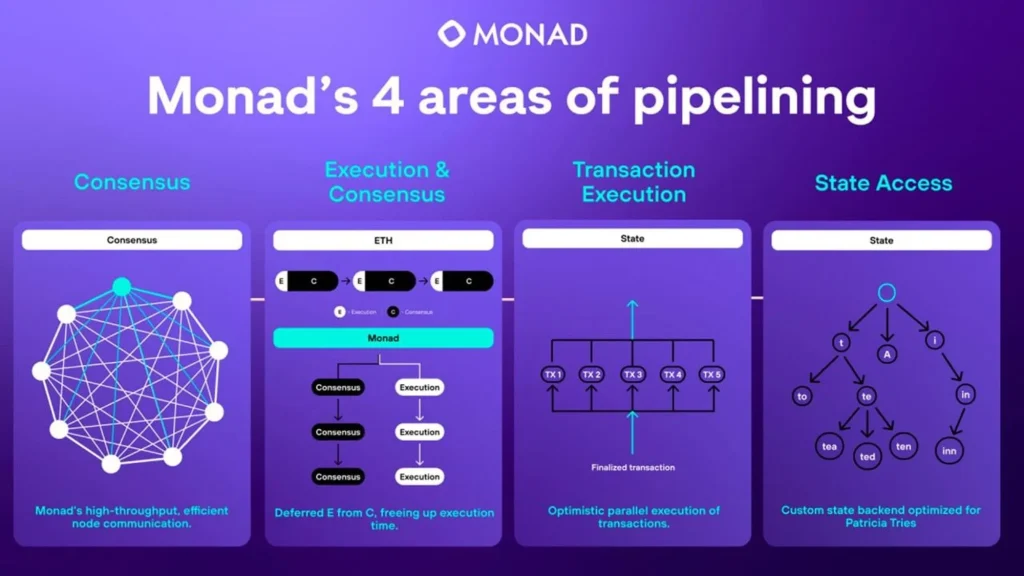
Optimistic Parallel Execution
Unlike traditional blockchains that validate transactions in a linear sequence, Monad applies optimistic execution, assuming that transactions are independent and can be processed simultaneously.
Key aspects of this mechanism include:
- Parallelized execution processes transactions concurrently instead of sequentially.
- Optimistic concurrency control runs transactions in parallel, resolving dependencies retroactively.
- Rollback & re-execution ensure accuracy while maximizing efficiency.
MonadDB for State Management
Monad introduces MonadDB, a custom-built blockchain state database designed to handle high transaction volumes efficiently. Traditional Ethereum clients use Merkle Patricia Trie (MPT) data structures, which are often embedded into B-Tree or LSM-Tree databases, leading to suboptimal storage performance. MonadDB addresses these inefficiencies through:
- Native Patricia Trie enhances Ethereum compatibility with better storage efficiency.
- Async I/O support (Linux io_uring) reduces latency for faster processing.
- Simultaneous reads/writes enable non-blocking state updates for transactions.
Asynchronous Execution
Monad incorporates asynchronous execution to decouple transaction validation from consensus, further improving scalability. This process, known as Deferred Execution, allows transactions to be ordered and validated before the execution occurs. Key features include:
- Execution separated from consensus speeds up block finalization.
- Non-blocking processing lets validators approve transactions without delays.
- Optimized mempool improves pending transaction handling.
Benefits of Using Monad
| Feature | Description |
|---|---|
| High Performance | Monad processes 10,000 TPS using parallel and deferred execution, far exceeding Ethereum’s ~15 TPS. |
| Lower Transaction Costs | Optimized execution and state management reduce gas fees while maintaining network security. |
| Full EVM Compatibility | Developers can seamlessly migrate Ethereum applications without modifying smart contracts. |
| Scalability Solutions | Innovations like MonadDB and asynchronous execution enable non-blocking transaction processing. |
| Enhanced Consensus Mechanism | MonadBFT, based on HotStuff BFT, improves consensus time while ensuring Byzantine Fault Tolerance (BFT). |
| Optimized Developer Experience | Supports Ethereum RPC API and standard Ethereum tooling for easy adoption. |
The Team Behind Monad
Founding Members
Monad was founded by Keone Hon (CEO), James Hunsaker (CTO), and Eunice Giarta (COO). The team has extensive experience in low-latency trading, distributed systems, and blockchain infrastructure.

- Keone Hon (CEO): Former Lead Engineer at Jump Trading, with expertise in high-frequency trading (HFT) and blockchain technology.

- James Hunsaker (CTO): Previously Vice President at J.P. Morgan and Goldman Sachs, before leading software engineering efforts at Jump Trading for eight years.

- Eunice Giarta (COO): Former Product Manager at Broadway Technology and Bank of America, with experience in financial technology and market infrastructure.
Investors
Monad has secured $244M in total funding, with backing from leading venture capital firms in the blockchain sector.
- Seed Round (February 2023): Raised $19M, led by Dragonfly Capital, with participation from Shima Capital, Placeholder Capital, and Lemniscap.
- Series A (April 2024): Secured $225M, led by Paradigm, with investments from Electric Capital, Coinbase Ventures, and GSR Ventures.
Tokenomics and Roadmap
Tokenomics of Monad (MON)
Monad has announced plans to introduce its native token, MON, which will serve as the primary medium for transaction fees and network security. However, specific details regarding total supply, token distribution, and economic model have not yet been disclosed. Key anticipated utilities of MON token include:
- Gas Fees
- Network Security
- Ecosystem Incentives
Roadmap
| Milestone | Date | Details |
|---|---|---|
| Project Inception | Feb 2022 | Secured $225M in Series A funding led by Paradigm. |
| Seed Round Raised | Feb 2023 | Raised $19M from Dragonfly Capital and other investors. |
| Technical Papers Released | Sep 2023 | Published documentation on Monad’s architecture and consensus model. |
| Devnet Launch | March 2024 | Monad was founded by ex-Jump Trading engineers. |
| Public Testnet Launch | Q2 2024 | Scheduled launch of Monad’s testnet for external developers. |
| Series A Funding | April 2024 | Secured $225M in Series A funding, led by Paradigm. |
| Mainnet Launch | Updating | Expected full deployment of Monad’s Layer 1 blockchain. |
Will Monad Airdrop?
As of February 27, 2025, Monad has not officially announced an airdrop for its MON token. However, with growing industry speculation and significant funding rounds, early engagement with the Monad testnet and ecosystem may increase eligibility for potential rewards.
Below are the steps to participate and maximize your chances of receiving a Monad airdrop.
Step 1: Acquiring $MON for Testnet
Method 1: Claim Free $MON Tokens
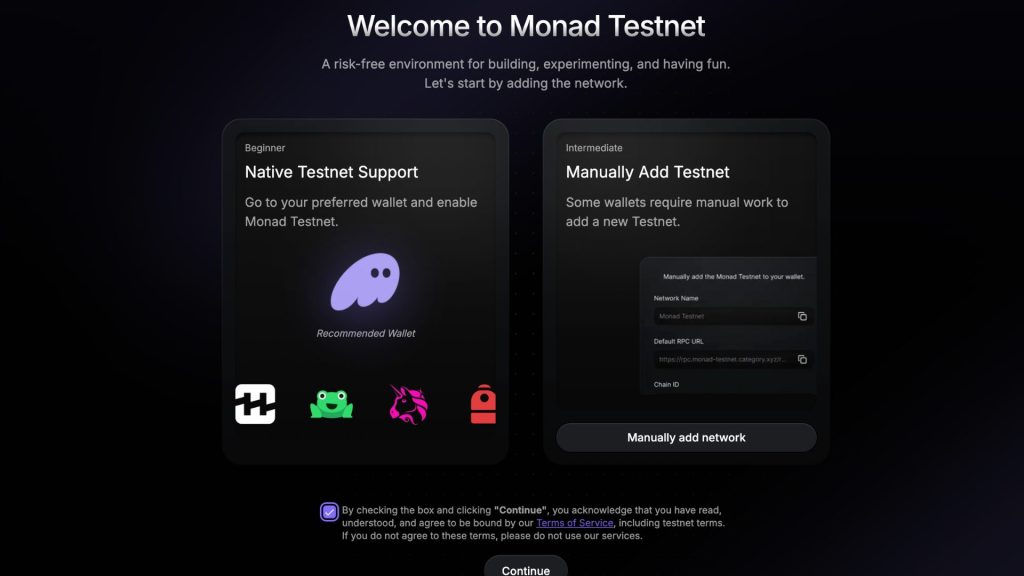
- Visit the Monad Testnet Faucet every 12 hours
- Click “Add Monad Testnet” to add the network to MetaMask
- Faucet Link: https://testnet.monad.xyz
- If your EVM wallet is active on-chain, you may receive automatic $MON airdrops
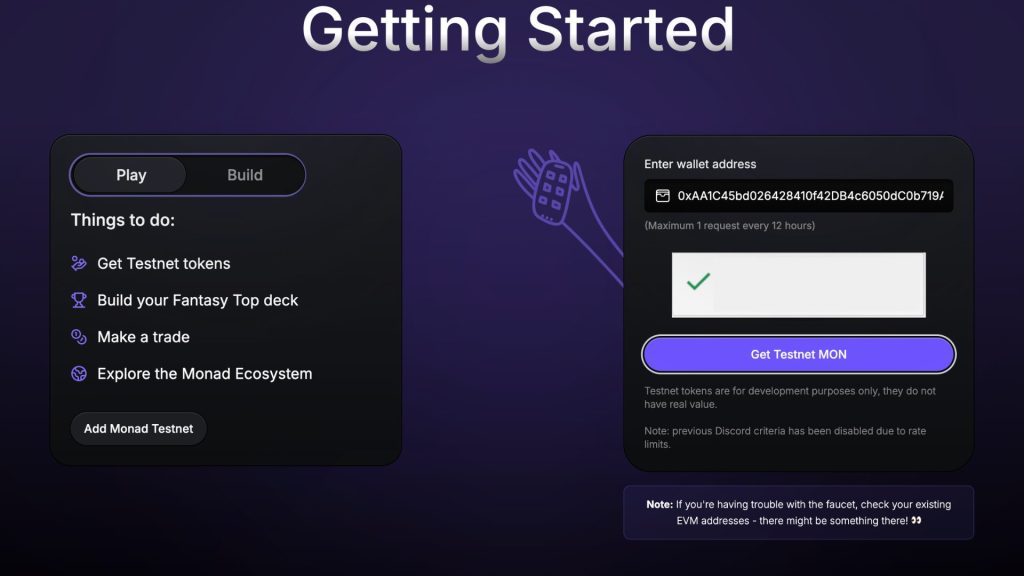
Method 2: Bridge ETH Sepolia to Monad
1. Get Sepolia ETH
- Use a faucet or purchase ETH Sepolia (0.001 ETH ≈ 12 ETH Sepolia)
- Faucet Link: https://testnetbridge.com/sepolia
2. Bridge ETH Sepolia → Monad Sepolia
- Use Orbiter Finance to transfer ETH Sepolia to Monad Sepolia
- Bridge Link: https://testnet.orbiter.finance/
3. Swap ETH → MON on Uniswap or Ambient Finance
- Enable testnet mode in the settings
- Select Monad Sepolia as the network
- 🔗 Uniswap Swap: https://app.uniswap.org/swap
- 🔗 Ambient Swap: https://monad.ambient.finance/trade
4. Swap ETH for MON (Exchange rates vary)
ETH Contract Address: 0x836047a99e11F376522B447bffb6e3495Dd0637c
Step 2: Exploring Monad Testnet Ecosystem
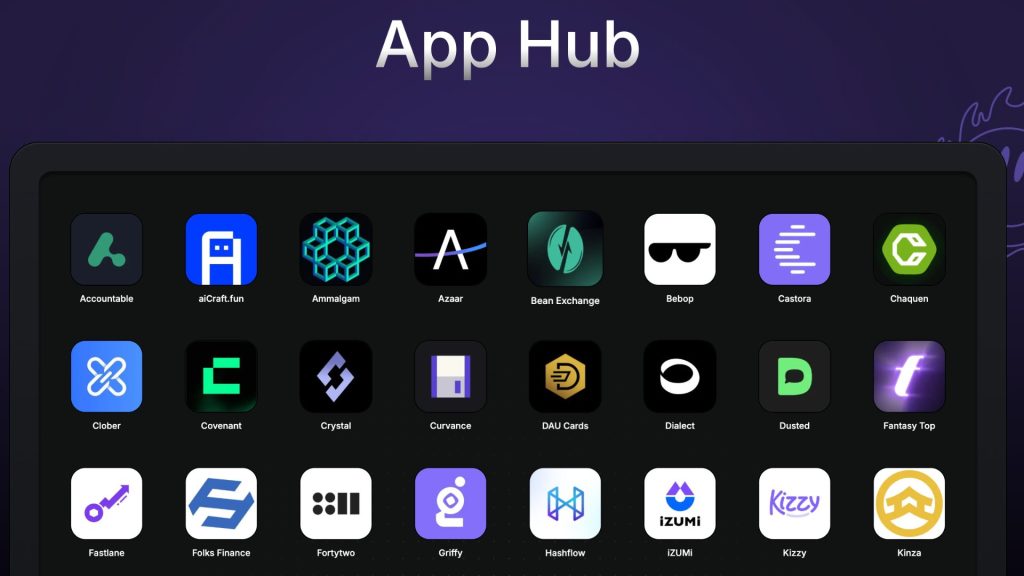
Full Ecosystem List: https://monad.xyz/ecosystem
NFT Minting & Domain Registration
| Platform | Action | Fee | Link |
|---|---|---|---|
| Chogstars | Mint NFT | 0.03 MON | https://testnet.lilchogstars.com |
| Monadverse | Mint 1 NFT (Paused) | N/A | https://monadverse.land/mint |
| Morkie | Complete tasks | Free | https://morkie.xyz/monad |
| MagicEden | Enter email to mint NFT | Free | https://magiceden.io/launchpad/monad-testnet/emmy_on_monad |
| Dominad | Register a Monad domain name | N/A | https://app.nad.domains |
| Owlto Finance | Deploy smart contracts | N/A | https://owlto.finance/deploy?chain=MonadTestnet |
| NFTs2Me | Create NFTs on Monad Testnet | N/A | https://nfts2me.com/create/edition |
DEX Trading, Liquidity Pools, and Swaps
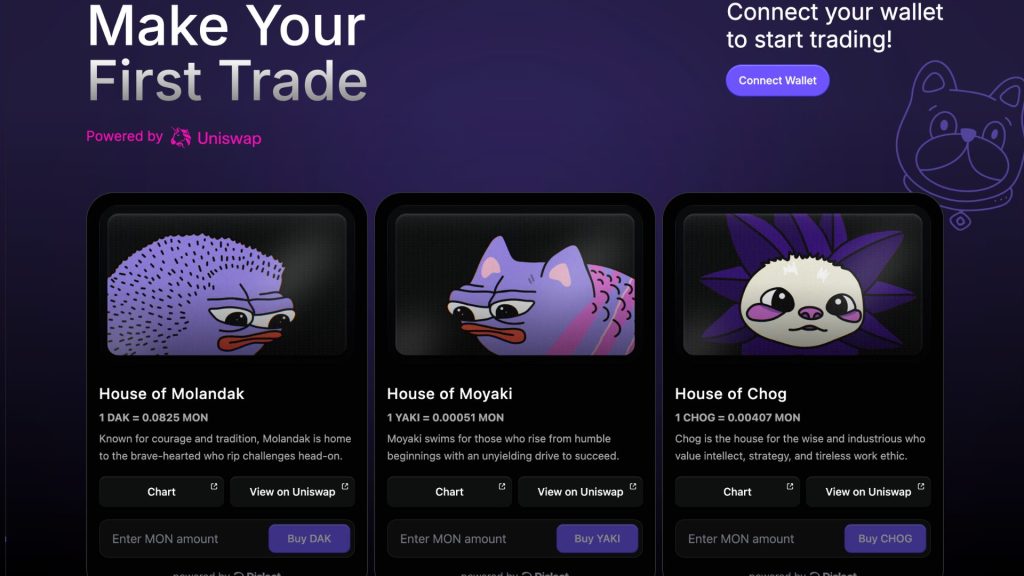
| Platform | Action | Link |
|---|---|---|
| Uniswap | Swap tokens on Monad Testnet (Enable testnet mode) | https://app.uniswap.org/swap |
| Bebop DEX | Swap tokens to create transaction volume | https://bebop.xyz/trade?network=monad |
| iZUMi Finance | Swap tokens on iZUMi DEX | https://alpha.izumi.finance/trade/swap |
| Kuru Exchange | Swap tokens on Kuru DEX | https://kuru.io/swap |
| Bean DEX | Swap tokens on BeanDex | https://swap.bean.exchange |
| aPriori Labs | Stake MON tokens | https://stake.apr.io |
Additional Testnet Interactions
| Platform | Action | Link |
|---|---|---|
| aiCraft Fun | Vote for an AI project agent | https://aicraft.fun/projects/fizen |
| NadFun | Create meme tokens | https://testnet.nad.fun/ref/POdPD5 |
| Folks Finance | Deposit MON tokens | https://testnet.xapp.folks.finance/deposit |
| Nostra Finance | Participate in lending and borrowing | https://monad.nostra.finance |
Complete Layer3 Quests for Additional Rewards
- Engage with testnet dApps and DeFi platforms to potentially qualify for future airdrops
- Stay active in the ecosystem and complete various tasks to enhance eligibility
- Monitor official Monad announcements for updates and new opportunities
Quest Link: https://app.layer3.xyz/quests
Frequently Asked Questions (FAQs)
What is Monad?
Monad is a Layer 1 blockchain with EVM compatibility, supporting 10,000 TPS through parallel execution and deferred execution for faster, lower-cost transactions.
When will Monad airdrop?
No official airdrop is announced. However, users can engage with Monad Testnet, interact with dApps, and complete Layer3 quests to qualify for rewards potentially.
Is Monad compatible with Ethereum applications?
Yes, Monad is fully EVM-compatible, supporting Ethereum wallets, RPC API, and smart contracts without modifications.
Who are the founders of Monad?
Monad was founded by:
- Keone Hon (CEO) – Former Lead Engineer at Jump Trading
- James Hunsaker (CTO) – Former VP at J.P. Morgan, Goldman Sachs
- Eunice Giarta (COO) – Former Product Manager at Bank of America
What are the hardware requirements for running a Monad node?
- CPU: 16-core processor
- RAM: 32 GB
- Storage: 2 TB NVMe SSD
- Bandwidth: 100 Mb/s
Further details on the validator node setup will be released closer to the mainnet launch.
| DISCLAIMER: The information on this website is provided as general market commentary and does not constitute investment advice. We encourage you to do your own research before investing. |










